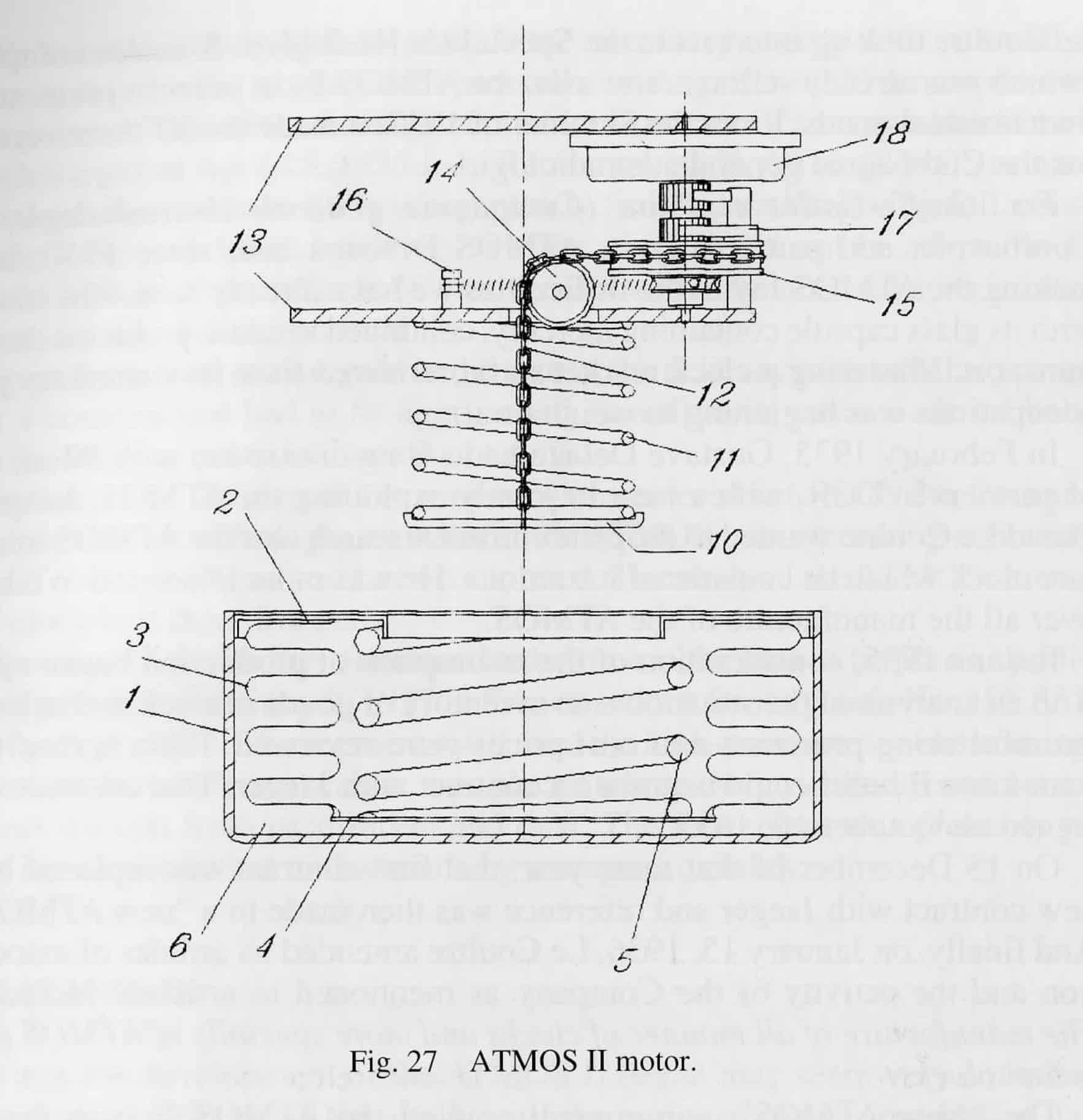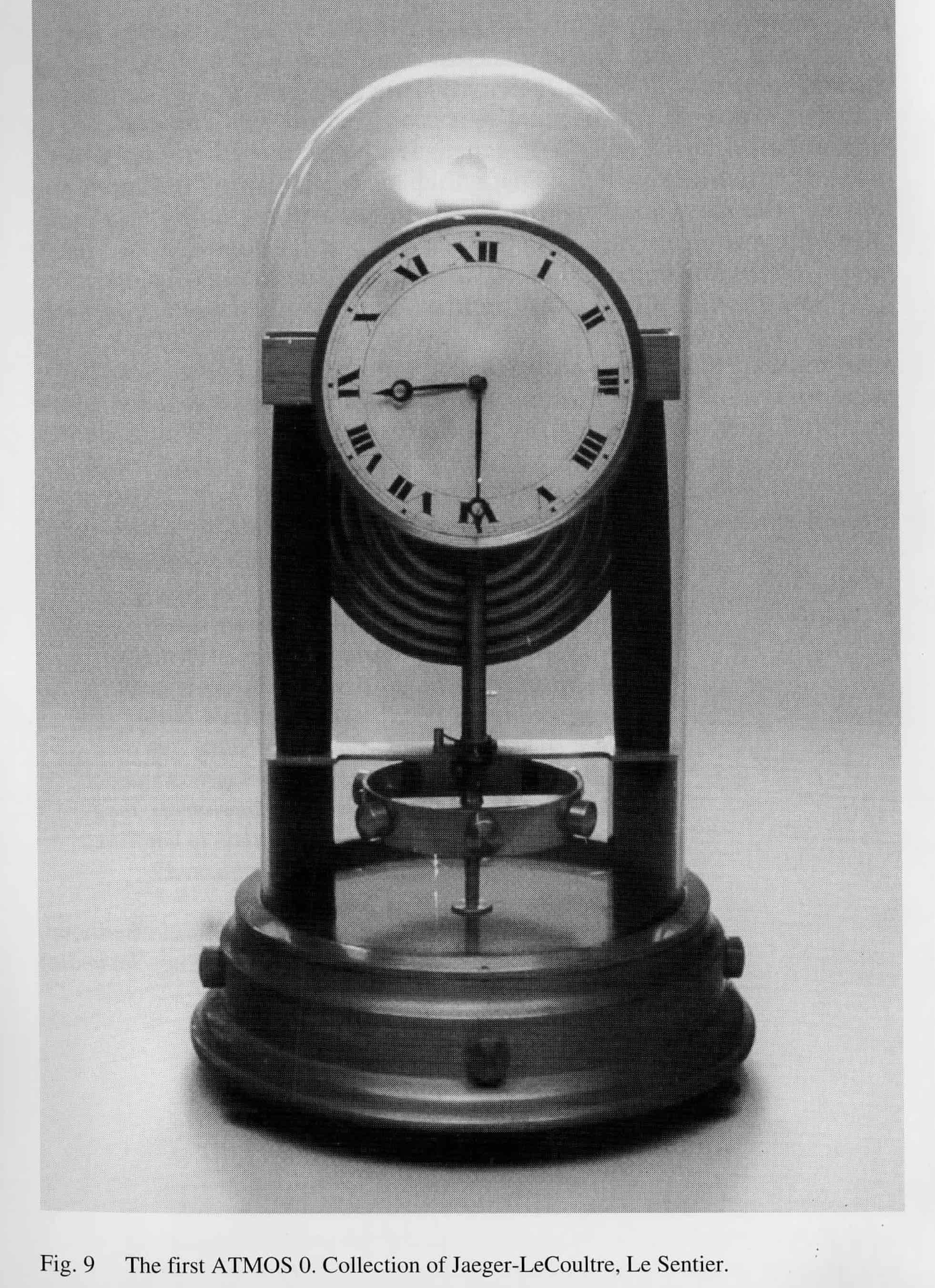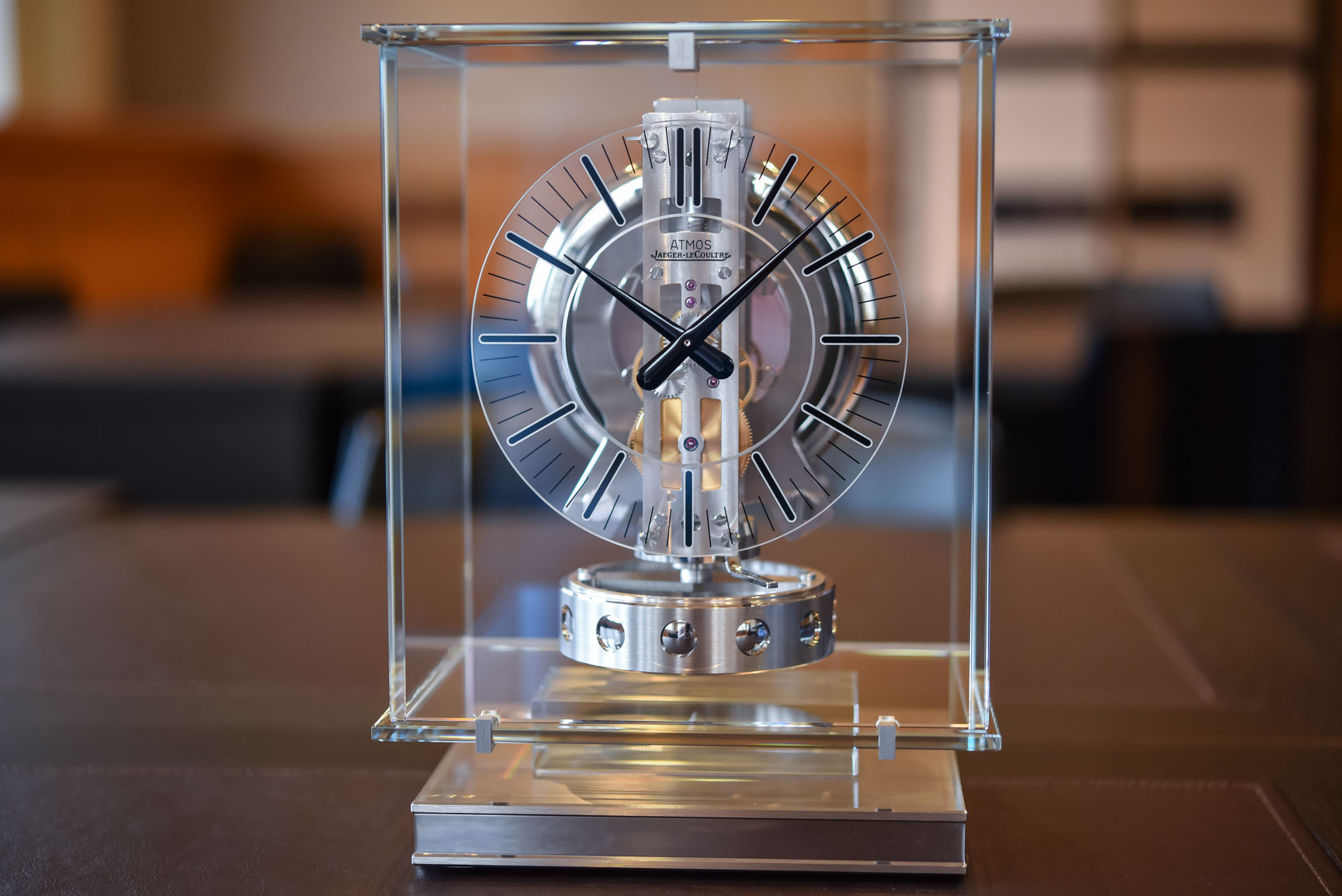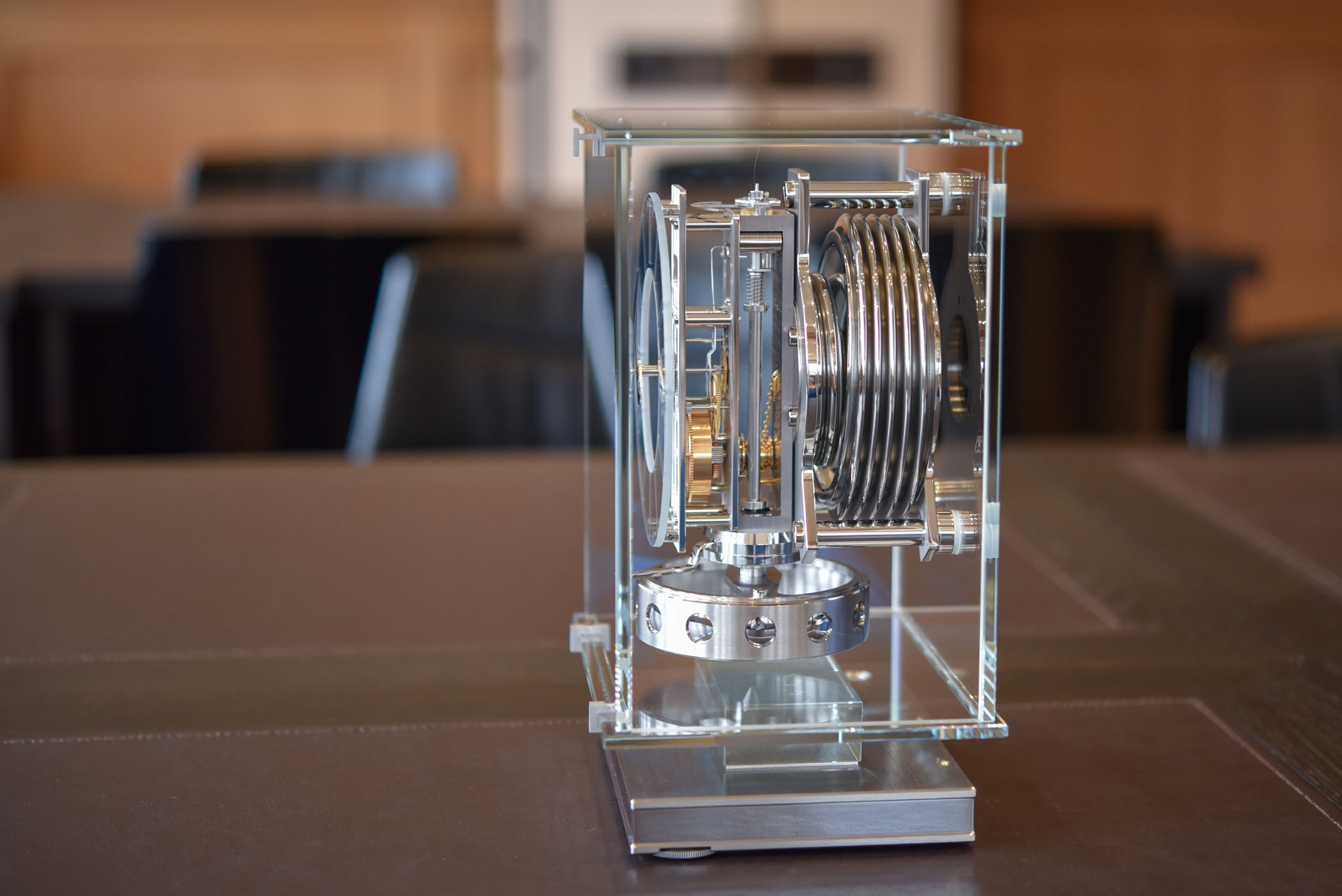Jaeger-LeCoultre Atmos Transparente (and Some Details on How it Works)
An invisible case for the invisible forces that will keep the Atmos ticking for perpetuity.

The reassuring tick-tock of the table clock has by and large been replaced by more modern contraptions for telling the time. Sadly, table clocks, once a ubiquitous presence on the mantelpiece of many homes, have gone the way of drinks trolleys and soda siphons. However, there is one table clock that has survived the tide of changing fashions and continues to fascinate with its perpetual movement activated by invisible changes in temperature: the Atmos. With no requirement to wind the movement, no hidden batteries, Jaeger-LeCoultre’s famous Atmos clock returns in a completely transparent case to reveal every detail of its movement that quite literally lives on air. Meet the new and modern Jaeger-LeCoultre Atmos Transparente.
Atmos Transparente
The Atmos Transparente (from atmosphere, the agent responsible for powering the mechanical movement) is a feast for lovers of mechanical spectacles. Its minimalist design and touches of Art Deco styling are housed in a glass box set on a rectangular steel base. Suspended in mid-air, the movement of the Atmos is exposed on all sides and at every angle through clear glass panels treated with anti-reflective coating. But before we review the clock, let’s take a look at the forces that shaped the Atmos.
The invisible and visible forces behind the Atmos
In a nutshell, the Atmos harnesses the daily variations in atmospheric pressure and temperature to power its functions. No winding, no batteries, no external intervention are needed to keep this clock ticking forever. Everybody knows that engineer Jean-León Reutter invented the Atmos and that it appeared on the market in the 1930s, but just how did this idea come to fruition?

The book Living on Air (1997) written by Jean Lebet, a thermal machine engineer from the Polytechnic Institute of Lausanne University, is dedicated with much devotion to the history of the Atmos clock. The author, who was hired in 1948 by Jacques-David Le Coultre, writes that he was asked “to create special machines and to maintain the machinery at the Le Coultre et Cie. clock and watch factory” and fell in love with the Atmos.

As Lebet explains, the concept behind the Atmos clock was hardly novel. Heron of Alexandria (10 AD – 70 AD), a mathematician and engineer from the aforementioned city, constructed automatic devices powered by hot air light years before the invention of the steam engine. However, as Lebet explains, the true forerunner of the Atmos was Swiss scientist and clockmaker Pierre de Rivaz who realised that heat, which causes metals to dilate and contract, hampered accuracy. His studies on thermal compensation led to the construction of a clock, in 1740, that rewound itself without human intervention. Countless others (including Friedrich Von Lössl, Charles Hour and Karl Heinrich Meier) would expand the concept of thermal compensation until Swiss engineer and inventor Jean-León Reutter (1899 – 1971) put all the pieces together and patented the first non-commercial prototype of a “clock that could be rewound by atmospheric fluctuations” in 1928, now referred to as the ‘Atmos 0’.
Reutter’s first Atmos 0 was housed in a glass bell jar with an airtight seal and two aneroid capsules driven by a mercury-in-glass expansion device. The idea was that variations in the temperature of the air trapped under the bell jar would cause the mercury to expand and contract. The thermal energy was then transmitted to a series of levers effectively converting thermal energy into mechanical energy. The effectiveness of this system meant that a variation of just one degree in temperature could provide energy to keep the clock running for 24 hours.
Although a couple of Swiss watch manufacturers – Longines and Ulysse Nardin – were offered this remarkable clock and turned it down, it was the Compagnie Générale de Radiologie (CGR) in France, where Reutters was employed as a radiology engineer, which manufactured the first commercial model in 1929 with its mercury and ammonia bellows. A department dedicated to the manufacture and sale of Atmos clocks was created within the CGR and Reutters duly appointed manager.

By 1933, Le Coultre was entrusted to supply movements to the CGR for its Atmos 1 clock (30” A calibre). Two years later, and following a period of touch and go, the CGR agreed for Reutter to negotiate a contract with LeCoultre (soon to become Jaeger-LeCoultre) and the Atmos 11 was sent to the R&D lab. Following countless setbacks, and having substituted the volatile mercury for ethyl chloride, production of the Atmos 11 began in 1939.
By the 1950s the Atmos clock had become a Swiss ambassador of sorts. Visiting heads of State, including Sir Winston Churchill, were often given an Atmos clock. In 1979, the Atmos celebrated its 50th anniversary and a Jubilee limited-edition model was released. Catering to the vicissitudes of changing tastes, the Atmos has appeared in manifold guises, from elaborate cabinets decorated with marquetry (ref. 226.027.2) to the more contemporary interpretation of this clock by renowned industrial designer Marc Newson.
Suspension of disbelief
Although the rational part of our brain knows how the movement works and that it is not suspended in mid-air, when you look at this Atmos Transparente you can really feel the magic. Compared to the other Classique Atmos clocks in the current line-up, with their metal-framed glass panels, Roman numerals and closed dials, the Atmos Trasparente pursues a sleeker, more minimalist design ethos. The crystal dial with its simple black baton hour markers and elegantly tapered glossy black hands does not hide an inch of the mechanical action. Just behind the central axis of the hands, you can see the vertical gear train and from the side, you can see the gas-filled bellows and the large annular balance wheel with its circular perforations at the base. Ticking at a stately 120 oscillations per hour and entirely manufactured and assembled by hand, the power reserve of the mechanical Jaeger-LeCoultre Calibre 563 is ‘virtually’ perpetual.
The Jaeger-LeCoultre Atmos Transparente measures 250mm x 185mm and 145mm and the base is made from stainless steel, which has been polished and satin-brushed for an elegant finish. The case is made from a new-generation colourless glass and treated with an anti-reflective coating. The Atmos Transparente retails for EUR 9,950 (incl. taxes).
More information at jaeger-lecoultre.com.









5 responses
Thanks for this article and pictures. It truly is a piece of art.
One remark though; In the article you use light years as a measure of time. Please don’t, it’s painful in an article about a clock.
Good article, I had forgotten about these clocks, nice to be reminded. I inherited an anniversary clock that operates at a similar rate, hypnotic to watch but is not a great deal of use for time keeping. How does the Atmos perform as a clock?
Merry Christmas everyone.
Wow what a piece. Great article.
It’s a shame not many people have a clock for their mantelpiece any more
How much temperature differens, schould be for the clock to winding the chain?